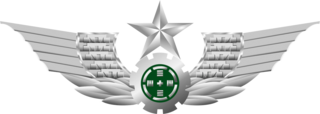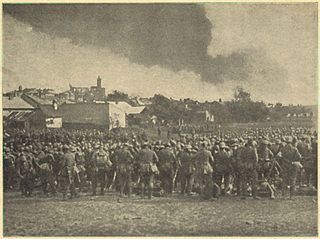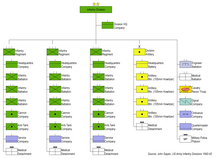A division is a large military unit or formation, usually consisting of between 6,000 and 25,000 soldiers. In most armies, a division is composed of several regiments or brigades; in turn, several divisions typically make up a corps.

A battalion is a military unit, typically consisting of 300 to 1,000 soldiers commanded by a lieutenant colonel, and subdivided into a number of companies. The typical battalion is built from three operational companies, one weapons company and one HQ company. In some countries, battalions are exclusively infantry, while in others battalions are unit-level organisations.

A regiment is a military unit. Its role and size varies markedly, depending on the country, service, or specialisation.

A brigade is a major tactical military formation that typically comprises three to six battalions plus supporting elements. It is roughly equivalent to an enlarged or reinforced regiment. Two or more brigades may constitute a division.

The People's Liberation Army Ground Force is the land-based service branch of the People's Liberation Army and the largest and oldest branch of the entire Chinese armed forces. The PLAGF can trace its lineage from 1927 as the Chinese Red Army; however, it was not officially established until 1948.
The Combat Arms Regimental System (CARS), was the method of assigning unit designations to units of some of the combat arms branches of the United States Army, including Infantry, Special Forces, Field Artillery, and Armor, from 1957 to 1981. Air Defense Artillery was added in 1968.
A regimental combat team (RCT) is a provisional major infantry unit which has seen use by branches of the United States Armed Forces. It is formed by augmenting a regular infantry regiment with smaller combat, combat support and combat service support units.
A triangular division is a designation given to the way military divisions are organized. In a triangular organization, the division's main body is composed of three regimental maneuver elements. These regiments may be controlled by a brigade headquarters or directly subordinated to the division commander. By contrast, in a square division, there were typically two brigades of two regiments. Other structures are possible, such as a pentomic division, where the division commander controls five maneuver elements, which was used in the United States Army in the late 1950s, with the regiments replaced by combined arms battlegroups.
Pentomic was a structure for infantry and airborne divisions adopted by the US Army between 1957 and 1963, in response to the potential use of tactical nuclear weapons, on future battlefields. It was intended that the five subordinate units, which were often referred to as battle groups, would be able to deploy and engage in operations more rapidly than conventional brigades, whilst also having greater offensive capabilities than conventional battalions.

The 1st Landwehr Division was an infantry division of the Imperial German Army during World War I. It was formed on the mobilization of the German Army in August 1914 under the "Higher Landwehr Commander 1" and, initially, also referred to as the "Landwehr-Division Goltz" after its commander. The Landwehr was the third category of the German Army, after the regular Army and the reserves. Thus Landwehr divisions were made up of older soldiers who had passed from the reserves, and were intended primarily for occupation and security duties rather than heavy combat.
This article details the organization of the Imperial Japanese Army.

The Sassari Mechanized Brigade is a mechanized infantry brigade of the Italian Army, based on the island of Sardinia. Its core are three infantry regiments which distinguished themselves in combat during World War I. Carrying the name of the Sardinian city of Sassari the brigade's coat of arms is modeled after the city's coat of arms. The brigade is part of the Division "Acqui".

The 158th Infantry Regiment ("Bushmasters") is an infantry unit of the Arizona National Guard. The regiment has served abroad in World War I, World War II and Afghanistan.

The Infantry Branch is a branch of the United States Army first established in 1775.

The 102nd Infantry Regiment currently consists of one battalion in the Connecticut National Guard. In the modern U.S. Army regimental system, regimental designation is used only in historical tradition, and there is no regimental headquarters or staff. It is one of several National Guard units with colonial roots. The 1st Battalion, 102nd Regiment is headquartered in New Haven, Connecticut. Its mascot is Sergeant Stubby.
The 307th Infantry Regiment was a National Army unit first organized for service in World War I as part of the 77th Division in France. It later served in the Pacific Theater during World War II. Since then it has served as a training Regiment. In 1999, it was withdrawn from the Combat Arms Regimental System and redesignated as a non-branch regiment. The regiment's 1st Battalion is assigned to the 174th Infantry Brigade at Joint Base McGuire–Dix–Lakehurst, New Jersey, with the 2nd Battalion is assigned to the 157th Infantry Brigade at Camp Atterbury, Indiana.
The 340th Infantry Regiment was a National Army unit first organized for service in World War I as part of the 85th Infantry Division in Europe. Since then it has served as a training regiment, training Army Reserve and Army National Guard soldiers fighting in the War in Afghanistan (2001-2021) and the War in Iraq.
The 351st Infantry Regiment was a National Army Infantry Regiment first organized for service in World War I as part of the 88th Infantry Division in Europe. It later served in the Mediterranean Theater during World War II. Since then it has served as a training Regiment, training Army Reserve and Army National Guard Soldiers for service overseas after the September 11 terrorist attacks.
A combat team is temporary grouping of military organizations of differing types to accomplish a defined mission or objective. Usage varies between commonwealth nations, where the term applies to a sub-unit level grouping, and the United States, where the term is found at unit and formation levels.
A brigade is a military formation utilized by the United States Army since its creation as the Continental Army. The brigade traces its origins to the British Army of the 15th century as a temporary formation to control multiple regiments when necessary. The US Army also maintained this status until the middle of the 20th century, when the first permanent brigades were formed. Traditionally brigades were composed of all one combat arm but with their permanent creation they evolved into combined arms formations. A brigade was historically commanded by a brigadier general and composed of several regiments, but is currently commanded by a colonel and composed of several battalions. In the US Army, maneuver brigades are composed of combat arms units which directly engage the enemy, while support brigades provide administrative and logistical support. Between three and six brigades in total form a division.










